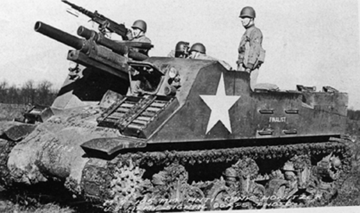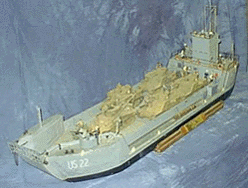
B Bty, 29th FA Battalion
D-Day and Beyond....!

|


|

|
They were lined up on the deck of an LCT (Landing Craft Tank), 2 in front and 2 in back. Their mission was
to fire high trajectory shells onto the invaded beaches in close support of our infantry. (Similar to the
model below).

|
We could do this because the tank treads on the M-7's could cushion the recoil, whereas the conventional
artillery pieces could not do this. The trails could not be dug into a steel deck. The
LCT carrying B Battery hit a mine in the water. My entire gun crew was lost. Only 2 members
of the battery who had been on board ever returned to active duty.
The reason I am still here to tell this story is that, in anticipation of casualties, the gun crews were
stripped down to 6 men and the remaining 6 men were kept in reserve on a larger ship. Subsequently we
had to clamber down rope ladders into an LCT with all our equipment for transport to the beach in the
late afternoon toward dusk.
Our 3/4 ton truck (weapons carrier) flooded immediately as it drove down the ramp of the LCT. The skipper
had dropped his ramp too far from the shore. It was getting dark and the tide was coming in and weighed
down as we were we might have drowned had not a DUKW (amphibious truck, affectionately dubbed by the GI's
as a DUCK) driver seen our plight and drove into the surf and came along side and rescued us.
When we learned of the fate of our battery mates we were dismayed to say the least. Until the battery was
reformed, about 2 weeks later, I was assigned to ride shotgun for a battalion messenger. In that capactity,
we sometimes lost our way and became great sniper targets, had flares dropped on us by night bombers, dubbed
Bed Check Charlie, because they only came out at night, and suffered through a head-on collision because of
driving in almost total blackout conditions.
German mortars were always a danger for us and we managed to dig deep into foxholes burrowed into the
headgerows.
When the battery was finally reformed with Captain Lorton Livingston in command, I became the #1 Cannoneer on
the Number 2 gun. My job was to set the elevation and altitude on the gun, close the breech block once the
shell was loaded, and fire the piece when given the command to do so. In this capacity, we burned out 2 gun
barrels and finally had to have our M-7's replaced with conventional artillery pieces.
Our 4th Infantry Division along with the 9th and 79th Divisions, liberated Cherbourg. We then were designated
to spearhead the St. Lo Breakthrough from Normandy. Despite a horrendous bombing from our own planes, our
8th Infantry Regiment made a deep penetration of the German lines, paving the way for expansion of the breakout
by the 2nd and 3rd Armored Divisions of the VII Corps of the 1st U.S. Army.
We were then designated as the division to liberate Paris, along with the 2nd French Armored Division. Our forward
units, according to infantrymen with whom I have spoken, could have entered the city before the French, but were
told to wait for the French. We penetrated to the heart of the city, around Notre Dame, the Place de La Concorde,
the Hotel de Ville, and the notorious Police Headquarters.
We were denied the honor of parading down the Champs Elysee. Our job was chasing Germans across the Seine River and
Belgium, and into Germany. And, besides, we were considered to be too dirty.
We advanced through Houffalize, St. Vith, and Bastogne, towns which later became famous in the Battle of the Bulge,
and crossed the German border on September 11, 1944. We were the first division to penetrate the German border in
force. We also penetrated the Siegfried Line in some depth before being forced to stop our advance because of our
extended supply lines.
The horrendous blood-letting of the Hurtgen Forest and our defense of the area in front of Luxembourg City, with a
badly depleted division, during the Battle of the Bulge were actions deemed worthy of feature stories in consecutive
issues of Life Magazine.
Of course, there is more that I have not included, such as helping to repulse the German counter attack at Mortain,
helping to clear out the German troops west of the Rhine River, crossing the Rhine at Worms, and advancing deep into
Bavaria to within 6 miles of the Austrian border.
My name is Irving Smolens. I was 74 years old on my last birthday, November 3. I live in Melrose, MA, an interior
suburb about 7 miles north of Boston. My email is ivrsmo@aol.com.